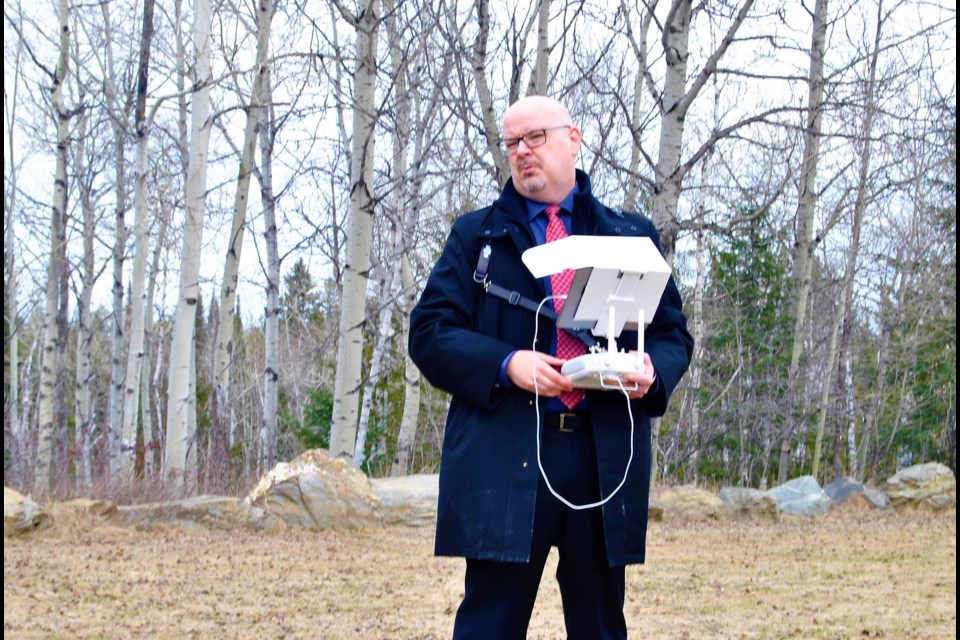It had the feel of one of those scientific experiments conducted behind a building out of sight and out of mind of the general public on a windswept April afternoon in Schumacher, Ontario.
On a raised mound stood Chad Mowbray, District School Board Ontario North East (DSBONE) principal of curriculum innovation and technology, whose mission is to transform learning to meet the needs of the 21st century; he is the lead on the iPad initiative, as well.
He could be a brainy scientist and he looked the part, on that windy day. This could be Kitty Hawk, North Carolina with the Wright Brothers about to fly their prototype plane, except it was much colder!
Mowbray, with a blue trench coat, flapping in the wind, and with a high tech-looking, white control panel strapped to his chest was about to explain his demonstration to a gathering of school board trustees including DSBONE chair, Doug Shearer, board administrators, reporters and young student robotics experts.
On the ground about thirty feet to his left stood a white, pizza shaped device on four pads raised about 12 inches above the still brownish back lawn of the DSBONE Education Centre on Croatia Avenue in Schumacher
It was a white drone.
Mowbray was going to put the high-tech disk through it’s paces.
He gave instructions on how to handle drones safely and cautioned the crowd not to get too close to the device especially while it was airborne.
“These drones have strict controls that must be followed,” Mowbray said. “They can go as fast as 70 Km per hour, but I will keep it in the slow mode we won’t go that fast.”
“Because of the wind, I am going to keep it in beginner mode,” explained Mowbray. “The beginner mode only gives me a 30-metre radius so I can only 30 metres to the side and only 30 metres off the ground.”
The drone that Mowbray flew remotely was equipped with a still camera and video.
He explained that devices such as this are already in use in the mining sector for exploration photography.
“Amazon, even uses them to make deliveries,” Mowbray remarked.
They cannot be flown near airports, or intrude in the flight path of airborne crafts. Drones cannot be flown beyond visual contact of its operator.
He pushed a button on the control device strapped to his chest and the four rotators started to turn and as they gathered speed, the pizza shaped white disk began to wobble and list as it surely started to gain altitude.
Two feet. Four Feet. Six feet.
The crowd stood and watched murmuring at what they were experiencing.
Ten feet. Straight up. 20 feet and as it reached its apex, Mowbray shifted the lever and the disk turned and took off away from the crowd way above the tree tops and into the low overhanging clouds.
'Oooh's and 'ahh's were heard.
Followed by hardy hand clapping. This was amazing.
“Will I get my pizzas delivered by drones,” someone joked.
“Forget about pizza delivery, can I take one of those to work and beat the ground level traffic,” another person said.
“It looks like a UFO,” a third person remarked especially as the tiny red lights came into view as the disk spinning way above the crowd for about 10 minutes before Mowbray returned the craft to earth with a gently, soft touchdown.
“In terms of the curricular use of drones, we have a lot of geography teachers interested in using drones because of they can be combined with geographical location technology and satellite imaging to produce some fascinating topographical images for teaching geography,” Mowbray remarked.
“In math classes, it can be used to teach coordinate geometry,” indicated Mowbray.
“It also be used in athletics training by being able to track a cross country runner or a track runner and the Phys Ed department can analyze the running technique to help improve the runner’s performance,” added Mowbray.
“The Ministry of Natural Resources is using drones to monitor our natural resources by doing tree and moose counts.,” he said. “Also, drones were being used in construction projects, such as at the new dam construction near Latchford, Ontario to see how the project was progressing, and to determine if the construction was meeting the specifications of the design.”
Doug Shearer, the Chair of DSBONE thanked Mowbray for the demonstration.
“This is a sample of where the Board and our schools are going with technology in our educational programs,” Shearer said.
Mowbray agreed with Shearer’s assessment on the importance of educating children on the latest technology.
“It’s important to bring the teaching of technologies like robotics and drone technology into our schools, because as one study pointed out, by 2035 up to 45 per cent of our current jobs will no longer exist,” said Mowbray. “If we don’t provide our children with education in high tech we will be doing them a huge disservice.
"We are going to introduce curriculum to teach technology to all of our students in all of our schools,” he said.
Mowbray said the drones are really new,” he said. “They are not in the schools yet.”
The first step is to teach the Innovation Coaches at each school across the school board and then introduce them into the individual schools.
“We hope to get them into the school this spring to whet their appetites and take it form there,” Mowbray said.
Meanwhile he pointed out that robotics is being taught at each DSBONE school from senior kindergarten to grade 12.



